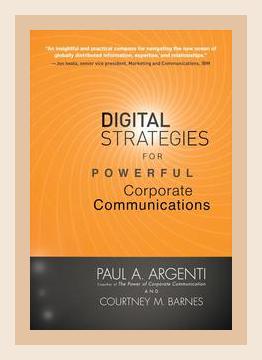Technology and Digital TransformationDigital Strategy
Introduction
Paul A. Argenti’s “Digital Strategies for Powerful Corporate Communications” delves into the transformative power of digital media in the realm of corporate communications. Published in 2009, the book is an essential guide for business leaders and communicators aiming to navigate the evolving digital landscape. Argenti highlights various strategies and tools that companies can leverage to enhance their corporate image, reach wider audiences, and engage more effectively with stakeholders.
Chapter 1: The Digital Revolution in Corporate Communications
Main Points:
1. Digital Transformation: Argenti begins by describing how the internet and digital technologies have fundamentally changed communication dynamics.
2. Interactivity and Real-Time Communication: Emphasis is placed on the shift from one-way communication to interactive, real-time engagement.
Examples and Actions:
– Example: Company’s use of social media platforms like Twitter to provide real-time updates and customer service.
– Action: Establish a robust social media presence for direct, immediate communication with customers.
Chapter 2: Building a Digital Communication Strategy
Main Points:
1. Strategic Planning: Argenti advises that a digital communication strategy should be integral to the overall corporate strategy.
2. Objectives and Metrics: The book discusses setting clear objectives and defining metrics to measure success.
Examples and Actions:
– Example: A tech company setting a goal to increase online engagement by 50% within six months.
– Action: Develop a digital communication plan that includes specific goals such as traffic growth, engagement rates, and brand sentiment analysis.
Chapter 3: Leveraging Corporate Websites
Main Points:
1. Corporate Websites as Communication Hubs: Argenti emphasizes the importance of an effective corporate website as the central hub of digital communication.
2. Content and Usability: The need for high-quality, relevant content that is easily accessible and user-friendly.
Examples and Actions:
– Example: IBM’s website offering comprehensive resources like white papers, case studies, and detailed product information.
– Action: Invest in a professional website design that is easy to navigate and regularly update content to keep it fresh and engaging.
Chapter 4: The Role of Blogs
Main Points:
1. Corporate Blogging: The potential of blogs to humanize the company and foster a direct connection with audiences.
2. Thought Leadership: Blogs as a platform for thought leadership and expertise.
Examples and Actions:
– Example: General Electric’s (GE) use of the “GE Reports” blog to share stories about innovation and developments.
– Action: Start a corporate blog where executives and employees can share insights, industry trends, and personal stories to build credibility and trust.
Chapter 5: Harnessing Social Media Networks
Main Points:
1. Social Media Strategy: Developing a comprehensive social media strategy tailored to the specific platforms and their unique audiences.
2. Engagement and Monitoring: Importance of continuous engagement and active monitoring of social media channels.
Examples and Actions:
– Example: Dell’s use of social media for customer service and feedback through its “Direct2Dell” initiative.
– Action: Create dedicated social media teams responsible for regular posting, engagement, and monitoring feedback to respond swiftly.
Chapter 6: Digital Storytelling
Main Points:
1. Storytelling Techniques: Using digital media to tell compelling stories that resonate with the audience.
2. Multimedia Content: Integrating various forms of media like videos, images, and interactive content to enhance storytelling.
Examples and Actions:
– Example: Coca-Cola’s “Share a Coke” campaign creating user-generated content through personalized stories.
– Action: Develop a content calendar that includes regular video content, behind-the-scenes stories, and interactive elements to engage viewers.
Chapter 7: Mobile Communications
Main Points:
1. Mobile-First Strategy: Given the increasing use of mobile devices, Argenti stresses the need for a mobile-first approach in corporate communications.
2. Mobile-Friendly Content: Ensuring that all digital content is optimized for mobile access.
Examples and Actions:
– Example: Starbucks utilizing its mobile app for personalized marketing and customer rewards.
– Action: Prioritize mobile-friendly design and functionality when developing web content and applications.
Chapter 8: Crisis Communication in the Digital Age
Main Points:
1. Crisis Management: Strategies for managing corporate crises using digital channels.
2. Speed and Transparency: The critical role of speed and transparency in crisis communication.
Examples and Actions:
– Example: JetBlue’s quick use of social media to address and manage customer issues during operational disruptions.
– Action: Prepare a crisis communication plan that includes protocols for immediate social media updates and real-time responses to stakeholder concerns.
Chapter 9: Measuring Digital Success
Main Points:
1. Analytics and Metrics: The importance of utilizing analytics to measure the impact and effectiveness of digital communication efforts.
2. Continuous Improvement: Using data to refine and enhance strategies.
Examples and Actions:
– Example: Procter & Gamble (P&G) analyzing social media data to improve its digital marketing campaigns.
– Action: Regularly track key metrics such as engagement rates, conversion rates, and customer feedback, and adjust strategies accordingly based on insights gained.
Conclusion
Paul A. Argenti’s “Digital Strategies for Powerful Corporate Communications” presents a comprehensive guide to leveraging digital media for corporate communication. It underscores the necessity for businesses to adapt to the digital age with strategic planning, effective use of platforms like social media, blogs, and mobile communications, and continuous measurement and refinement of strategies. Implementing these strategies can significantly enhance stakeholder engagement, improve brand perception, and drive business success. As Argenti emphasizes, the digital transformation of corporate communication is not optional but essential for staying relevant and competitive in today’s fast-paced world.
